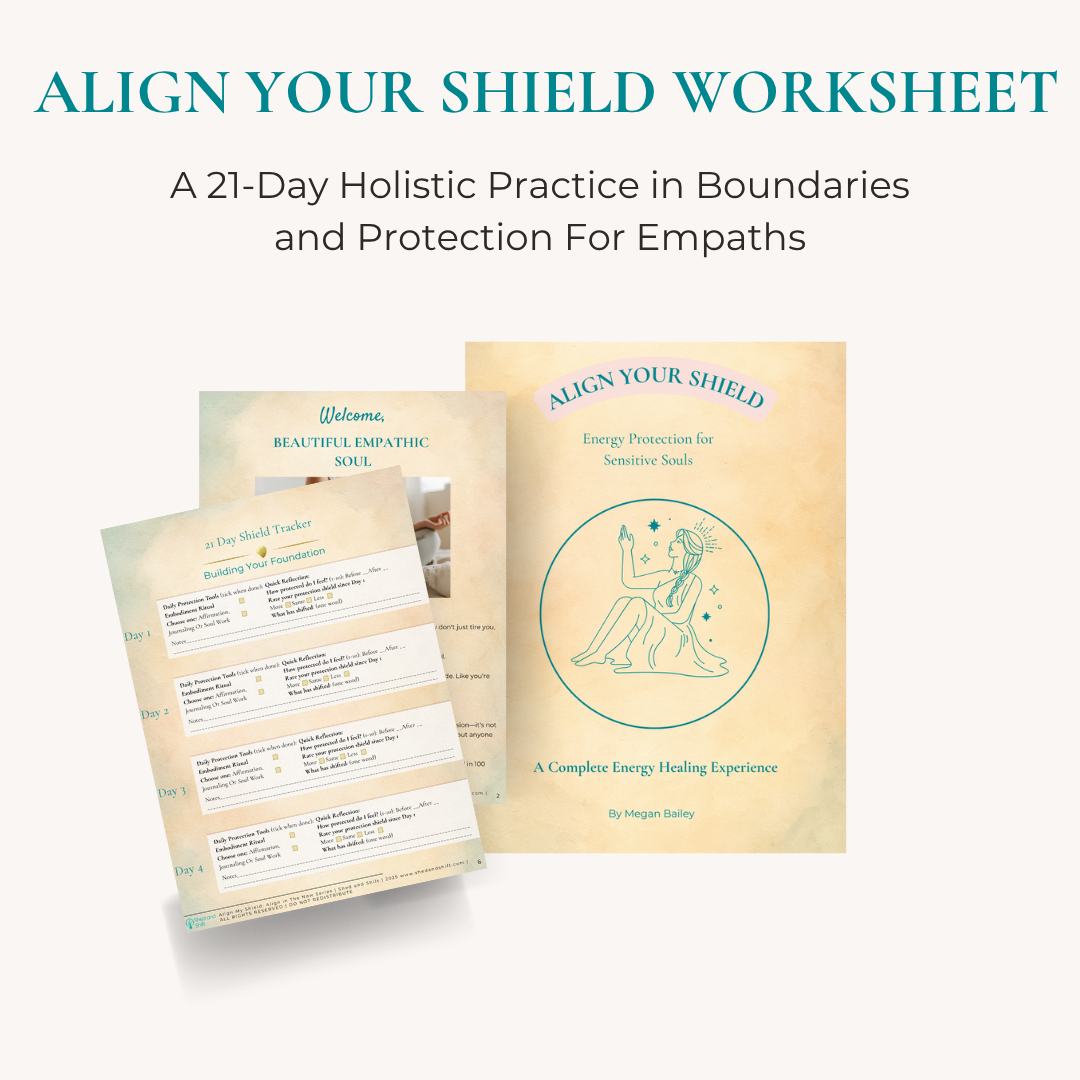Mind Activation
Shadow Work vs Light Work for Empaths:
5 Key Differences & Which To Do First

Shadow Work vs Light Work for Empaths: What You Need to Know
If someone had told you five years ago that meditation would make you more anxious instead of less, you would have laughed. But here you are—months into a daily practice, and your nervous system feels more frayed than ever.
It’s not just meditation either. You tried the gratitude practice. You visualized white light protection. You worked on raising your vibration. You connected to your higher self. All the spiritual tools that seem to bring everyone else peace just leave you feeling more scattered.
The spiritual world has been clear about what you need: light work. Stay positive. Raise your consciousness. Open your heart. Connect to something greater. These practices work miracles for so many people. The testimonials prove it.
So why do they leave you feeling worse instead of better?
Here’s what no one tells empaths: those practices assume you need to learn how to expand. To open more. To connect more deeply. But you already know how to do that. You’ve been doing it your entire life—feeling everyone’s emotions, merging with the energy of every room you enter, connecting so deeply you lose track of where you end and others begin.
You don’t need more expansion. You need the opposite. You need to learn how to come back to yourself. How to contract. How to build a foundation underneath all that openness.
That’s the difference between shadow work and light work. And for empaths, getting the order wrong is why nothing seems to work.
You’ve probably heard these terms thrown around in spiritual circles, but nobody’s explained what they actually mean FOR YOU. Nobody’s told you why one works and the other doesn’t. Nobody’s given you the real reason meditation leaves you more anxious, or why all that inner work feels like it’s making things worse.
Let me break down what each one actually is, how they differ, and why shadow work has to come first.
What Light Work Actually Is
So what exactly is this “light work” you’ve been attempting?
It’s the spiritual practice of connecting to higher consciousness, positive energy, and elevated states. You know—meditation. Gratitude practices. Affirmations. Working with guides or angels. Energy healing. Visualization techniques. All the things everyone keeps recommending.
It’s called “light work” because the whole point is raising your vibration and aligning with love, peace, and joy.
The goal? Spiritual expansion. You’re reaching upward to connect with something greater than your current state. Opening to oneness. Being of service. Holding space for others.
And here’s what makes this so complicated for you: light work is your soul’s natural language.
You’re already wired for connection. Already open. Already feeling the collective. You don’t have to learn how to be empathic—it’s your default setting. You don’t have to practice feeling what others feel—you’ve been doing it since childhood. You don’t have to develop your ability to hold space—you do it instinctively, often without even realizing it.
Light work comes naturally to you because expansion is what you’re designed for. Your soul came here built for oneness, for connection, for holding light for others.
And if you’re reading this thinking you don’t feel naturally connected or open—that’s perfectly okay. You may be in empathy misalignment. You just don’t yet have the tools to hold your light. That’s what shadow work builds.
What Shadow Work Really Is
Shadow work is what happens when you finally turn toward what you’ve been avoiding. What you’ve rejected, hidden, or pushed into darkness. It’s facing the emotions you were taught not to feel. The needs you learned to suppress. The parts of yourself you decided weren’t acceptable.
Your shadow isn’t just negative emotions—it’s anything you’ve disowned.
The anger your family told you was inappropriate. The grief you never had permission to fully express. The word “no” that feels impossible to say. The boundaries that feel selfish. The needs that seem like too much.
For most people, shadow work is about integrating those rejected parts of themselves. But for you as an empath? Shadow work is something more fundamental.
It’s about coming back to yourself at all.
You’ve been so focused on expansion—on feeling everyone else, connecting to everything, being of service—that you’ve lost the foundation of self. You walk into a room feeling fine and leave feeling inexplicably anxious—but it wasn’t yours to begin with. You can feel everyone’s emotions but struggle to identify your own.
Shadow work for you isn’t just about facing what you’ve rejected. It’s about establishing what got lost in all the expansion: your center. Your boundaries. Your sovereignty. The container that can actually hold your light instead of scattering it everywhere until you’re depleted.
Think of yourself as a lighthouse. Your soul’s purpose is to hold light and shine it out to guide others—that’s light work, and it comes naturally to you. But if the lighthouse has no foundation, if it’s just light floating in the ocean with no structure, it can’t fulfill its purpose. The light scatters in every direction. The lighthouse gets swept away by waves. It can’t stand steady enough to actually guide anyone.
Shadow work builds the lighthouse structure.
And that’s why the order matters so much.
The 5 Key Differences
| Aspect | Light Work | Shadow Work |
|---|---|---|
| Direction | Expansion, connection, oneness | Contraction, returning to self, establishing center |
| Focus | Others, collective, service, spiritual connection | Self, sovereignty, boundaries, personal identity |
| Feels Like | Natural and easy (you’re wired for it) | Uncomfortable (contraction feels wrong when you’re designed for expansion) |
| What It Does | Expands your capacity to hold and share light | Builds the container so you can hold light sustainably |
| Examples | Connection, healing others, feeling oneness, being of service | Boundaries, saying no, identifying your emotions, pulling back from merging |
Difference #1: Direction—Expansion vs. Coming Back to Center
Light work moves you outward and upward. You’re expanding your consciousness, connecting to the collective, feeling into oneness with everything around you. You’re reaching for higher states, opening to spiritual connection, extending your energy to hold space for others.
Shadow work? It moves you inward and asks you to contract. You’re pulling your energy back to center, establishing the boundary between your emotional experience and the collective field you’re swimming in, coming back to the foundation of self.
At six years old, you walked into the kitchen and felt your mother’s sadness before she said a word. By twelve, you were the friend everyone came to because you just knew what they needed. You didn’t learn this—you’ve been doing it since your nervous system came online.
You’re designed for oneness. It’s your gift.
But here’s what happens when you only expand: you lose yourself in the process.
You become so diffused, so merged with everyone else, that you can’t locate your own center anymore. You’re everywhere and nowhere at the same time. You can feel everyone’s pain but can’t identify your own. You know what everyone needs but have no idea what you need.
Shadow work creates the contraction. The pulling back to center. The inward movement that gives your expansion somewhere to return to.
Think about breathing. You can’t only inhale. Your body needs both the expansion of breathing in AND the contraction of breathing out. Without the exhale, you can’t take another breath. You just stay expanded until your system is overwhelmed.
That’s what’s happening when light work makes you feel worse. You’re being asked to expand when you’re already expanded beyond your capacity. You need the contraction first—the return to center—before you can expand again in a way that’s sustainable.
Shadow work teaches you how to breathe out. How to pull your energy back. How to locate yourself after merging. How to establish the foundation that your expansion can return to.
This is the lighthouse foundation work. You need both movements. But if you’ve only been expanding, you need to learn contraction first.
Difference #2: Focus—Service to Others vs. Sovereignty of Self
Light work focuses outward—on others, the collective, being of service, holding space, healing, connecting. You’re directing your attention and energy toward what others need, how you can help, how you can hold light for people who are struggling.
Shadow work focuses inward—on you. Your sovereignty. Your boundaries. Your identity. You’re directing attention toward what YOU need, what YOU feel, where YOUR limits are, who YOU are when you’re not merged with everyone else.
You’ve been focused outward your entire life. It’s not something you chose—it’s how you’re wired.
Your attention is always outward. Before your partner even speaks, you’re already feeling what they need. Your friend texts ‘I’m fine’ and you’re already reaching out because you sense the struggle underneath. Your focus lives in other people’s emotional states—it’s your default setting.
But here’s what decades of outward focus creates: you have no idea what YOU need.
You can name exactly what your best friend needs right now, but you can’t name what YOU need. Her emotions are clearer to you than your own.
Shadow work teaches you inward focus. It asks uncomfortable questions:
What do YOU feel right now—not what you’re picking up from others, but what’s actually yours?
What do YOU need—not what others need from you?
Where are YOUR boundaries—not where you think they should be to keep others comfortable?
Who are YOU when you’re not merged with someone else’s experience?
These questions feel selfish at first. They feel wrong. You’re designed for service, for connection, for holding others. Focusing on yourself feels like abandoning your purpose.
But here’s what shadow work is actually asking you to do: establish the self that does the serving.
You can’t hold space for others when you have no space for yourself. You can’t be of service from an empty foundation. You can’t give from a well that’s run dry.
Remember the lighthouse? Shadow work isn’t teaching you to stop serving. It’s teaching you to establish sovereignty WHILE serving. To know where you end and others begin. To have a self to return to after holding space. To build the foundation that makes service sustainable instead of depleting.
Difference #3: How It Feels—Natural Expansion vs. Uncomfortable Contraction
Light work feels natural and easy for you. Meditation comes easily when you can access it. Connecting to spiritual guidance feels like coming home. Feeling oneness with others is your baseline state. Opening your heart, holding space, sensing energy—all of this is instinctive.
You don’t have to learn how to be empathic. You have to learn how to put boundaries around your empathic nature so it doesn’t consume you.
Shadow work feels uncomfortable and unnatural. Pulling your energy back feels wrong. Saying no creates guilt that sits in your chest for days. Establishing boundaries feels like building walls that go against your nature. Focusing on yourself instead of others triggers the belief that you’re being selfish.
Last time you said no to a friend’s request, you felt it in your body for three days. The guilt sat in your chest like a stone. You checked your phone obsessively. You replayed the conversation wondering if you were cruel. That’s what contraction feels like when you’ve spent a lifetime expanding—like abandoning your soul’s purpose.
But contraction isn’t the opposite of your nature. It’s the support system FOR your nature.
You can’t only inhale. **Back to the lighthouse—**it can’t only shine outward—it needs the structure that holds it in place. Your empathic gifts can’t only expand—they need the foundation that gives them somewhere to return to.
Shadow work creates that structure. The discomfort doesn’t mean you’re failing. It means you’re building the capacity that makes your natural gifts sustainable instead of depleting.
Think of it like strength training. The resistance is uncomfortable. The muscle burn feels wrong at first. But the discomfort is what creates the strength. Without it, your muscles stay weak.
Shadow work is strength training for your empathic system. The contraction feels uncomfortable because it’s new. But it’s what creates the capacity to hold your natural expansion without collapsing under the weight of it.
Difference #4: What It Does—Expanding Capacity vs. Building the Container
Light work expands your capacity to hold and share light. It strengthens your connection to spiritual guidance, deepens your ability to feel oneness, enhances your natural gifts of empathy and intuition.
Shadow work builds the container that holds all of that capacity. It establishes the boundaries that prevent depletion, creates the foundation that keeps you grounded, develops the sovereignty that lets you be of service without losing yourself in the process.
Your soul came here to hold light. That’s not in question.
You’re already doing it. You’ve been holding light for others your whole life, often without conscious intention. You feel their pain and want to ease it. You sense their needs and meet them. You naturally channel healing energy just by being present.
The problem isn’t your capacity to hold light. The problem is that you have no container to hold it in.
Without a container, holding light depletes you. **The lighthouse with no structure can’t keep shining—**eventually the ocean swallows it. You hold space for everyone else until there’s no space left for you. You give and give and give until you’re running on empty, wondering why you feel so exhausted when you’re “doing what you’re meant to do.”
You’re exhausted because you’ve been trying to hold an ocean of light with no walls to contain it.
Shadow work builds those walls. It establishes boundaries—not to keep others out, but to contain your light so it can shine steadily instead of scattering in every direction. It teaches you to identify your own emotions so you’re not constantly drowning in everyone else’s. It helps you say no so your yes actually means something.
Once the container is built, your light work becomes powerful in a completely different way.
You can hold space for others without losing yourself. You can be of service without depletion. You can connect to oneness and still return to your center. You can expand into spiritual states and contract back to yourself. You can give from a full well instead of an empty one.
Your natural gifts finally have the structure they need to be sustainable.
The lighthouse stands steady on solid ground, and its light can shine exactly where it’s meant to—not scattered across the ocean, but focused, steady, guiding.
Difference #5: Examples—What Comes Naturally vs. What Requires Practice
Light work practices include:
- Meditation and connecting to inner peace
- Feeling oneness with others and the universe
- Healing work—energy healing, holding space, offering support
- Intuitive gifts—sensing what others feel and need
- Spiritual connection—working with guides, channeling, prayer
- Being of service naturally and instinctively
Shadow work practices include:
- Establishing boundaries and saying no without guilt
- Identifying YOUR emotions separate from what you’ve absorbed
- Pulling your energy back to center after merging with others
- Recognizing where you’ve lost yourself in service
- Processing emotions you’ve been taught not to express (anger, needs, desires)
- Coming back to yourself instead of staying expanded
Look at those two lists for a moment.
Everything in the light work column probably feels familiar. Natural. Something you already do without trying.
Your healing abilities aren’t dormant gifts waiting to be awakened—they’re overactive and flooding your system every moment of every day.
Now look at the shadow work list.
Everything there probably feels harder. Less natural. Something you actively resist.
Boundaries feel mean. Saying no triggers guilt that lasts for days. Pulling back from someone’s pain feels like abandonment. Focusing on your own needs feels selfish. Identifying which emotions are actually yours feels impossible when you’re drowning in everyone else’s.
These aren’t natural skills for you. They require conscious practice. They feel like going against your nature because you’ve never developed them.
This is why you need shadow work first.
You’re already doing light work. Probably too much of it. You’re already expanded, already connected, already giving, already holding space, already feeling everyone’s emotions, already merged with the collective.
What you haven’t learned is how to contract. How to return to yourself. How to pull your energy back. How to establish the foundation that makes all that expansion sustainable.
Shadow work doesn’t teach you to stop being empathic. It doesn’t shut down your gifts. It doesn’t make you less connected or less capable of holding space.
It teaches you to be empathic WITH a foundation. WITH boundaries. WITH a self to return to. WITH the capacity to give without depleting yourself in the process.
This is the lighthouse structure work. You learn to shine from a steady structure instead of being swept away by every wave
Which Should You Do First?
Shadow work. Always shadow work first for empaths.
Not because light work is wrong—light work is your soul’s natural language. But because you’ve been doing light work your entire life without the foundation to sustain it.
You’ve been expanding, connecting, feeling, serving, holding space for others since childhood. You’re probably exhausted. You’ve probably lost track of who you are underneath all the merging. You probably can’t tell where your emotions end and everyone else’s begin.
Shadow work teaches you the skills that don’t come naturally: boundaries, contraction, sovereignty, returning to self. It builds the lighthouse structure so your natural light can shine steadily instead of scattering until you’re depleted.
Once you’ve established that foundation—once you know where you end and others begin, once you can say no without days of guilt, once you can identify your actual emotions—THEN your light work becomes sustainable.
You can meditate without drowning in absorbed energy. You can be of service without losing yourself. You can hold space for others while maintaining space for yourself. You can expand into spiritual connection and contract back to your center. You can be the lighthouse you were designed to be—steady, grounded, shining from a solid foundation.
You need both practices. But shadow work builds the container that makes your natural light work powerful instead of depleting.
Ready To Build Your Foundation?
Shadow Alchemy sessions are designed specifically for empaths who need to establish the foundation beneath their light. This work helps you return to yourself, establish boundaries that support your gifts, and build the container that makes your natural empathy sustainable instead of exhausting.
Book your Shadow Alchemy session here
Frequently Asked Questions
Can empaths do light work and shadow work at the same time?
Yes, but shadow work should be your primary focus first. Think of it like building a house—you can start planning the interior design while laying the foundation, but if you skip the foundation work entirely, the house won’t stand. Start with shadow work practices (identifying your emotions vs absorbed ones, establishing boundaries, coming back to center) and layer in light work practices as you build capacity. Once you have a solid foundation, both practices work together beautifully.
Why does light work feel impossible for empaths?
Light work asks you to expand and connect—but you’re already TOO expanded and connected. You’ve been merging with everyone’s emotions, holding space for others, and staying open since childhood. When you try to meditate or “raise your vibration,” you’re attempting to access peace while your system is already overflowing with everyone else’s energy. It’s not that light work doesn’t work for empaths—it’s that it requires the foundation of shadow work first.
How long does shadow work take for empaths?
Shadow work isn’t a destination—it’s an ongoing practice of returning to yourself. Most empaths need several months of consistent shadow work before light work becomes genuinely accessible. You’re learning skills that don’t come naturally (boundaries, saying no, identifying your own emotions) and unlearning decades of conditioning that taught you to prioritize everyone else. Give yourself at least 3-6 months of focused shadow work before expecting light work practices to feel sustainable.
Is shadow work just therapy for empaths?
Shadow work can include therapy, but it’s broader than that. Therapy often focuses on processing your personal wounds and traumas. Shadow work for empaths includes that, but also addresses your empathic wiring specifically—learning to identify absorbed vs personal emotions, establishing energetic boundaries, developing sovereignty while maintaining connection, and building the container that holds your light. Many empaths benefit from both therapy AND empath-specific shadow work practices.
What if I'm already exhausted—how can I do MORE work?
Shadow work for empaths isn’t about adding more to your plate. It’s about RELEASING what you’ve been carrying that was never yours to hold. The exhaustion you feel is likely from decades of expansion without contraction, giving without receiving, holding space for everyone else while having no space for yourself. Shadow work creates relief—it teaches you to discharge absorbed energy, pull back from constant service, and establish boundaries that protect your energy. Most empaths feel LESS exhausted once they start shadow work, not more.
I’m an empath from South Africa. I found my path as a healer in my 20s—not because I had it figured out, but because I knew deep in my soul I was meant to heal others.
For 15 years, I’ve walked this path—not because it was easy, but because it’s my soul’s calling.
I know what it’s like to absorb everyone’s emotions, to feel too much, to wonder if being this sensitive means something is wrong with you.
Here’s what I discovered: Your empathy isn’t the problem—it’s that nobody taught you how to work WITH your sensitive system instead of against it.
Now I help empaths transform through the trinity of mind, body, and soul healing—because surface fixes don’t work when you feel everything at a cellular level.
This is my life’s work. Empath to empath. Heart to heart.
Ready to remember your power?
Get The Lastest Blogs
Keep Reading
You may also like:







